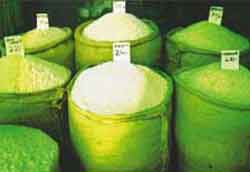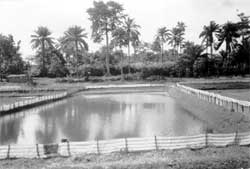
Hi tech harvests
Rural agricultural practices in the UK maybe in for an automation invasion. Robots, instead of humans, will pick and sort through vegetables and fruits, milk cows and guide farm vehicles

Rural agricultural practices in the UK maybe in for an automation invasion. Robots, instead of humans, will pick and sort through vegetables and fruits, milk cows and guide farm vehicles

Village Chipri in Kolhapur, Maharashtra is fighting: diseases, a factory and lax authorities
LTTE's water war: In the last week of July, the Sri Lankan army launched a ground offensive against Tamil tiger rebels to regain control over a key water reservoir in the northeastern city of
Goa In April 2007, the Bombay High Court dropped all proceedings against Amar K Vazirani, member secretary of Goa State Pollution Control Board (GSPCB), accepting his explanation for the delay in

Can information sharing make

Economic considerations override conservation priorities in India s biodiversity act

Warehousing Bill, a double edged sword for farmers
There seems to be no end to sugarcane farmers' misery in the State who every year face the problem of excess production. The farmers this time have taken to the streets expressing their displeasure with the sugarcane package announced by the government. Karnataka stands fourth in the country in the cultivation of sugarcane but the State is yet to see a sugarcane policy or a scientific basis for fixing the minimum support price. The farmers blame the sugar mills, the factory owners in turn blame the government, the government feels that the mill owners and farmers are both at fault for not coming to a consensus, thus completing the vicious cycle. Elected representatives on their part keep using the sugarcane pricing issue to fuel anger among the farmers (to keep the vote bank intact) but there is no permanent solution to the problem. Deccan Herald presents a lowdown on the state of affairs from the eyes of various stake-holders. The sugar industry in Karnataka can be divided into two groups - unorganised sector which comprises of the producers of the traditional sweeteners such as gur and khandasari and the organised sector which consists of the sugar mills. Farmers' woes: *Dictatorial attitude of sugar mills. Last year a majority of mills refused to implement the statutory minimum price fixed by the government. The State government had directed all co-operative sugar mills to pay farmers Rs 1,200 for a tonne of sugarcane. Except two or three mills, others paid only between Rs 600 and Rs 800 a tonne. *No action was initiated against mills which did not follow the State government directions. *The dues owed to farmers by the mills exceed Rs 160 crore *The recently announced sugarcane package does not solve the problem of growers being offered a low price for their produce or the glut in sugarcane production. * No policy for use of by-products like molasses and bagasse Mill owners' take *The sugar market has fallen. Paying Rs 1,200 per tonne for sugarcane as demanded by farmers is suicidal. * Mills have been accumulating losses. *The recovery (sugar content) is less than 9 per cent compared to 11 pc in other states. Hence rates prevalent in other states cannot be implement . * There is no proper distribution of mills especially in the sugarcane growing belt * No scientific basis for arriving at the minimum support price The way out *A comprehensive sugar policy that spells out the cropping pattern. *Farmers could be allowed to take up production of jaggery on a large-scale to utilise the excess sugarcane. *Govt should announce minimum support price for jaggery at Rs 1,500 a quintal. The present price of Rs 600 a quintal is not remunerative. *Mismanagement of mills need to be curbed.
FOOD MANAGEMENT: Foodgrain stock at 19.2 MT on January 1 this year is 4% lower than the buffer norm of 20 MT. The Economic Survey 2007-08 points to the lower than normative foodgrain stocks for the third consecutive year, caused mainly by the decline in procurement of wheat and rice and their increased offtake under the targeted public distribution system. The foodgrain stock stood at 19.2 million tonnes (MT) as on January 1, 2008, comprising 11.5 million tonnes of rice and 7.7 MT of wheat, respectively. This stock is 4 per cent lower than the buffer norm of 20 MT. Last year, only wheat stock was short of buffer norm. While wheat stock of 7.7 MT is 500,000 tonnes lower than the required norm, the rice stock stood at 11.5 MT, that is 300,000 tonnes lower than the norm. According to the survey, the main reason behind the decline in stocks was due to lower procurement in both wheat and rice. The survey attributes the decline in wheat procurement to low production, lower market arrivals, high market ruling prices, negative market sentiments due to low stocks in the central pool, and aggressive purchase by the private traders. It acknowledges that the increase in government procurement price by Rs 150 a quintal during the 2007-08 marketing season helped wheat procurement to a small extent. The procurement rose by 20.65 per cent to 11.1 MT but the government had to contract imports of 1.8 MT at high rates to meet the consumption requirement. This was the second consecutive year of wheat import. However, rice procurement also fell marginally to 26.3 MT during 2006-07 from 26.7 MT during 2005-06. However, in the ongoing 2007-08 season, procurement till December has been marginally better than the previous season's corresponding purchase. The increase in paddy procurement price by Rs 125 a quintal has helped rice availability in the central pool this year. The regulation of rice export by putting a price cap has also contributed. The offtake of both wheat and rice increased marginally in the April-December period of 2007-08. Wheat offtake during the period was 8.2 MT (against 7.7 MT in the previous year's corresponding period) while the rice offtake was 16.7 MT (versus 15.9 MT in the year before).
DEBT WAIVER The loan waiver will benefit about 30 million small and marginal farmers. In an apparent move to appease the huge rural vote bank, the government today announced the biggest-ever agricultural loan waiver package that will cost the exchequer a whopping Rs 60,000 crore. The move will benefit about 30 million small and marginal farmers, whose debts worth Rs 50,000 crore will be completely waived, and about 10 million other farmers. Under this package, while all the outstanding unpaid loans of small and marginal farmers will be totally waived, the other farmers will have to repay only 75 per cent of the borrowed amount under one-time settlement arrangement. Announcing the largesse in his budget speech, Finance Minister P Chidambaram said the agricultural loans, which were restructured or rescheduled in 2004 and 2006, would also be eligible for loan waiver and concessional repayment through one-time settlement arrangement. All agricultural loans disbursed by the scheduled commercial banks, regional rural banks and cooperative credit institutions up to March 31, 2007, and overdue as on December 31, 2007, but not repaid till today, would be covered under this debt waiver-cum-relief scheme. The tillers of up to one hectare of land would be considered marginal farmers and those having one to two hectares of land would be deemed small farmers. The finance minister announced that the implementation of the scheme would be completed by June 30, 2008. The farmers would become entitled for fresh agricultural loans from the banks after the debt waiver or signing an agreement for repayment of 75 per cent amount under the one-time settlement arrangement. He, however, did not elaborate on how the banks would be compensated for the waived loans. Referring to the indebtedness of the farmers, Chidambaram pointed out that the government had appointed a committee under the chairmanship of R Radhakarishna to examine all aspect of this issue. "The committee had made a number of recommendations but stopped short of recommending waiver of agricultural loans.' The finance minister, however, sought to justify this populist move, maintaining that the government was conscious of the dimensions of the problem and was sensitive to the difficulties of the farming community. He also asserted that the government had carefully weighed the pros and cons of debt waiver and had also taken into account the resource position while taking this decision. Chidambaram told Parliament that notwithstanding some shortcomings, the growth of agricultural credit had been impressive. "We will exceed the target set for 2007-08. For 2008-09, I propose to set a target of Rs 2,80,000 crore.' he said. He thanked the commercial banks and regional rural banks which, together, accounted for between 75 and 79 per cent of agricultural credit disbursed during the year. Chidambaram said short-term crop loans would continue to be disbursed at an annual interest rate of 7 per cent, adding that an initial provision of Rs 1,600 crore had been made for interest subvention in 2008-09.
The State Food and Civil Supplies Minister, Dr Nazrul Hussain today told the Assembly that deficit production and increase of price at source due to rising demand were at the root of the price rise in essential commodities, especially foodgrains, in the State. Replying to a question raised by Ananta Deka of CPM during zero hour, Dr Islam said that the current price rise was a national phenomenon and affected Assam and the North-East more because of the transportation costs. The Minister said that his department was coordinating with district and subdivisional administrations for properly monitoring the developments so that unscrupulous elements could not take advantage of the situation. The situation in places like Delhi, Kolkata, Hyderabad, Jaipur, etc., were also kept track of and constantly compared with that of the State. "Deficit production in rice, dal, wheat, mustard, etc., and the lowering of Government subsidies are having an impact on price rise. The recent export of 5 lakh MT rice to Bangladesh has also added to the growing demand in the source States,' Dr Islam said. "Common rice which was sold at Rs 12 a kg in Kolkata on October 8, 2007 shot up to Rs 14 on February 8, 2008. The same rice is being sold in Delhi at Rs 17 a kg. In Guwahati, common rice which fetched Rs 12.50-Rs 14 a kg in October last year, was sold at Rs 14-Rs 16 in January,' he said. The Minister further said that the rise in import prices of various edible oils was contributing to the price rise. "India imports a sizeable quantity of refined vegetable oil and refined rapeseed oil from Malaysia, and recently there has been considerable increase in the their prices. Again, mustard oil produced in the country has also become costlier,' he said. Dr Islam said that the department, during 2007, registered 726 cases regarding the public distribution system (PDS), which "showed that we are taking steps to streamline the system.' Moreover, the Bureau of Investigation of Economic Offences (BIEO) has been entrusted with the job of making an inquiry into the PDS scam that rocked the State last year. Dr Islam said that the six per cent railway fare cut for the North-Eastern States would come into effect from April only.
Holding down inflation and interest rates, energising the production function, pushing investments, saving livelihoods, and raising incomes and consumption became the principal objectives of the Budget. The waiver of farm loans is a means to the accomplishment of these goals. G. Ramachandran First things ought to come first. There is an exaggerated view that the waiver of farm loans is senseless and indefensible. The waiver has been criticised on the grounds that it would vitiate the credit culture and exacerbate moral hazard in banking. The critics have no such views when commercial and industrial loans remain unpaid or are waived and written off. The waiver of farm loans is a wholly sensible and defensible decision. The waiver at its worst estimate is expected to cost the exchequer a big sum of Rs 60,000 crore. But it will most likely trigger an increase in gross domestic product (GDP) of over Rs 3,72,000 crore over the next three years. The exchequer will earn at least Rs 44,000 crore if the tax-to-GDP ratio is 12 per cent. The nominal net loss could at worst be Rs 16,000 crore. But there may be no loss at all. The loss could turn into a sizeable profit. There are three reasons for this optimism. First, the loss to the exchequer would be lower when the other robust stimuli to growth act upon the economy. Second, the waiver would break the logjam in the fallow farmlands. It will put crops back on cultivable lands that have remained fallow. A spurt in output will kill inflation. Third, lower inflation will keep interest rates low. Nonperforming assets of banks will rebound smartly. Therefore, law-abiding taxpayers and conscientious borrowers that repay loans have nothing to fear. Smartly managerial The Finance Minister has acquired a reputation for smart and conscientious fiscal management since 2006. He has managed India's fat fixed costs of running government pragmatically. He has outrun the beastly costs by taking a managerial view of tax revenues. He has stimulated tax inflows by lowering the unit excise duty rates. He has raised the threshold of the service tax. The raising of the personal tax threshold level and the slabs expands incomes that can be allocated to consumption. It expands the size of the indirect tax market as a result. Yet, it ensures that the good times of ordinary people will continue. The cut in excise duties applicable to many consumption goods and consumer durables deserves special attention. Compliant and conscientious The boost to consumption may appear scandalous. But the Finance Minister has stayed steadfastly on course to meet the requirements of the Fiscal Responsibility and Budget Management Act (FRBMA). Ernst & Young, a global accounting confirm, has aptly commented that India has
PRODUCING a newspaper or a newsmagazine is something like an unending string of little miracles. As technologists designing new machines well know, "if anything can go wrong, it will." The same

An African nation refuses international aid and sets up a highly ambitious agenda to stand on its own feet

The use and abuse of wood is a major theme in the history of humankind according to a new book, A Forest Journey
Nanuram Rawat was the adhyaksha of the gram sabha in Seed, one of the first gramdan villages where environmental resources have been regenerated through community management

Indian lakes are no longer serene waterbodies. Instead, they have become stinking cesspools, a result of continuous inflow of sewage and massive siltation. As the lakes die a premature death, the question that arises is who is responsible for this sorry s

The aromatic enigma makes basmati a clear winner among grains. The lack of knowledge of what traditional basmati is and an inability to take cognisance of whatever little is known made India a loser in international trade

Making the best of the worst could be the underlying theme behind the garbage revolution in Nigeria

The panchayats of Sonrai in Uttar Pradesh and Palana in Rajasthan share a Jawahar Rozgar Yojana experience. Both ignored the water needs of the villagers and spent the money instead on projects that are not even being maintained properly.